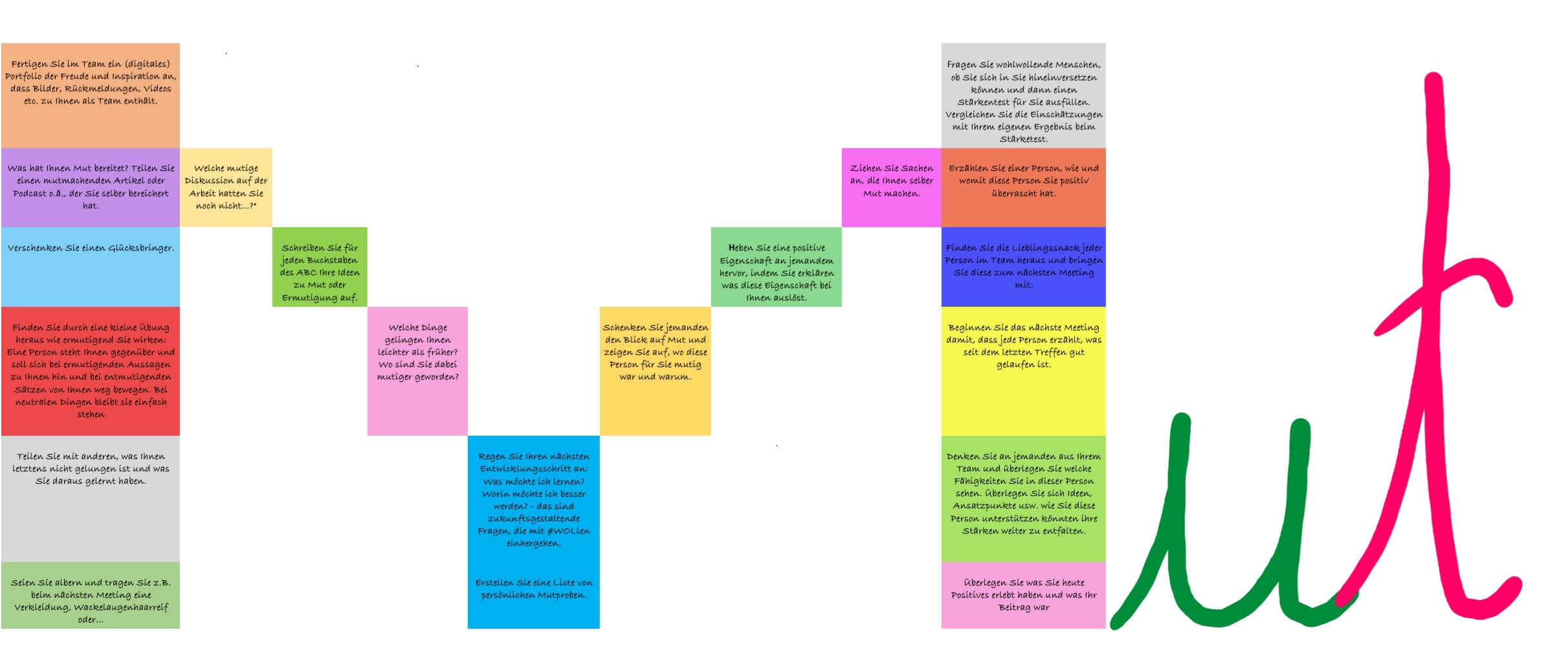Spotlight on: Encourage!
Pauline’s struggle from the previous two articles on encouragement is representative of an example of people who are waiting for an encouraging push. Encouragement is a sign of attention that encourages others or oneself. In practice, encouragement can come through actions, words, an encouraging climate or encouragers. But what does this look like in practice?Pauline’s struggle from the previous two articles on encouragement is representative of an example of people who are waiting for an encouraging push. Encouragement is a sign of attention that encourages others or oneself. In practice, encouragement can come through actions, words, an encouraging climate or encouragers. But what does this look like in practice?
The theory says that encouragement is directed towards future successes and makes courageous action possible in the first place. Atmospheric encouragement plays a role in this, which is reflected in the climate of the company as well as in the relationships of the people involved. Here again, factors of the encouraging person, such as his or her attitude and skills, come into play. Regardless of the basic theoretical direction, different subject areas flow into each other when looking at courage and encouragement.
In the studies and research on courage, the same characteristics crystallise as in the literature on aspects that promote innovation. Examples include autonomy, trust, openness or the ability to learn (learning culture). These in turn have overlaps with, for example, the psychological foundations of interpersonal cooperation and thus take up the point of encouraging attitudes and abilities, which can be found again in the quality of interaction from the perspective of the quality dimensions. Or put much more simply in the words of Dirk Gently: “Everything is interwoven”. The statement is meant to make clear that the topic of courage has a multifaceted spectrum of topics and fields of action, into which findings from (positive) psychology or innovation research, studies on feedback or empowerment, among others, flow. What they have in common is that they focus on the growth and development of people and/or organisations. These ideas and theoretical considerations can be interlinked to show possibilities for strengthening courageous and future-oriented action.
Ultimately, the focus in practical action should be less on the theoretical subtleties, inconsistencies or differences, but rather shine its spotlight on the effectiveness of the actions. What becomes more important, therefore, is what contributes to a change in action and thinking. In this sense, I can only agree with Theo Schoenacker’s statement regarding the distinction between praise and encouragement, because “if this hair-splitting would slow down your spontaneity to say something good to someone. Then I wish you would live by the motto: ‘It is better to encourage wrongly than not to encourage’.”1
The Buddy Principle
Let’s start with something you surely remember from your kindergarten or school days. The buddy principle, which can be found in modified form in a wide variety of institutions and formats, such as job sharing or pair programming. Buddies look out for each other, are there for each other and learn together. In this context, the buddies work together on the tasks that arise in the company, whereby the depth of the work can vary greatly. For example, professional sparring can be in the foreground, e.g. as joint brainstorming on a task or an exchange about the status quo. Regardless of the design, at least two people know what the respective task is about and form a mutual backup. In addition, the joint exchange makes it possible to reflect on work steps and, if necessary, to restructure them. Another effect of a two-person constellation can be the representation of one’s own opinion. Thanks to the buddy’s support, you are less alone and more likely to try out new ideas together and deal with criticism more easily. It is not for nothing that, for example, in intervention training with regard to violence, it is postulated to specifically approach another person and ask for help, because in groups the courage level can increase and the willingness to help increases. A buddy team thus creates relief and security, also for the other colleagues. A study of a variant of the buddy principle, job sharing, confirms the positive aspects in terms of satisfaction in the cooperation both in tandem and for the colleagues.2
Heroic stories are also based on the principle of a community that encourages each other. Think of the heroic duo Old Shatterhand and Winnetou or the Community of Nine from The Lord of the Rings: Would Frodo have succeeded in his mission without Sam? What about Batman and Alfred or the crime duo “The 2”? Do you still know the feeling when, during activities such as going to the gym, visiting a museum or studying, learning a software programme, you yourself don’t feel like doing it and want to give up, and a colleague, your girlfriend or your life partner encourages you to continue? It is precisely at this moment that you strengthen your own perseverance, one of the qualities with which the character strength courage is connected.
Small signs of attention
Another simple and quick encouragement is the “thumbs up” signal. For example, if you know that your colleague is as excited as Pauline is at a public lecture, accompany her and give her a thumbs-up or a smile in between. If you are unable to attend, send her a short encouraging message via Slack, Threema or your favourite communication channel. Ideally, you will link to an event she has previously mastered and reflect what skills you have noticed. Encouragement leads to courage also contains a small exercise on how you can make the effect of a “thumbs up” tangible in the team. These small signs of attention strengthen self-efficacy for a short time.
Strengthen strengths
Every individual is a bundle of strengths and weaknesses, but without recognising one’s own strengths and weaknesses, it is more difficult to assess situations. Courage, for example, can turn into overconfidence. With the awareness of what is best about oneself, how one expresses and behaves becomes clear at the same time. If you do not know what you are capable of, you will probably not be able to make satisfactory use of your possibilities. People who are able to play to their strengths in their professional context show higher levels of job satisfaction, commitment and productivity, as research by the Gallup Organisation has repeatedly shown.
In a team, knowledge of the respective strengths helps in mastering the tasks. For example, one colleague has strong creativity, while another colleague has strong bonding skills and therefore thrives on networking. With the awareness of the strengths of the individual team members, tasks can be approached consciously and strength-based. In addition, the delegation and acceptance of new tasks can have an encouraging effect, since, for example, a colleague is trusted with the task of taking over the training for the clientele XYZ, although this activity, according to the job profile, falls into the area of responsibility of another colleague. Assigning this task also relieves the colleague who does not enjoy teaching content and thus has a lasting effect on the effectiveness of the training as well as on her satisfaction.
You can discover your own strengths with the help of the University of Zurich’s online test (in German), among other things. By looking at your strengths, your own perception is changed at the same time and your creative space is expanded, because a more intensive, targeted preoccupation with strengths is transferred to other areas at the same time. This effect is called the “Tetris effect”: This means that if you are a strengths discoverer for yourself, you are very likely to discover the strengths of your colleagues as well.6 Ultimately, as Peter Drucker puts it, it is about “getting people to perform together” in a way that “makes their strengths effective and their weaknesses irrelevant”.7
Think for yourself and together in the team how you can contribute your respective strengths or in which activities or projects you have contributed them. Make a list of your top 5 tasks in your professional or private environment and think about how you can use one of your identified top strengths for these activities. In more depth, you can ask yourself why each strength is significant to you or to what extent the strengths describe you.
Other strength-based interventions related to character strength courage are, for example, positively naming efforts instead of an outcome or making a positive re-evaluation so that “keeping going” does not dry up. You know this experience from sport: there is a game coming up and you know in advance that the chance of losing as the bottom of the table is high. Coaxing a la “it’ll work out” blinds you to reality. Instead, the focus should be on what can be learned from the situation besides the defeat and what the defeat could also be good for.
„Shiny Happy People“
Based on the song “Shiny Happy People” by R.E.M., happy people with their positive emotions can create a shiny glow that acts like a shield against negative experiences. Driving away negativity was also one of the motivations that found influence in carnival or carnival traditions and rituals a long time ago. Whether carnival or comedy, both use the power of laughter and humour: by mocking fears or parodying grievances, as well as turning the frightening or given into the absurd. Laughing together awakens positive emotions, creates a bond between people and can promote courage. Humour helps to put failures into perspective and to release strength for a new attempt. The effectiveness of positive emotions such as humour has been scientifically proven in many ways, for example through the research of psychologist Barbara Fredrickson. She has identified the ten forms of a positive attitude to life:
- joy,
- gratitude,
- cheerfulness,
- interest,
- hope,
- pride,
- pleasure,
- inspiration,
- awe and
- love.
Especially cheerfulness, hope in the sense of confidence, showing interest as well as love are forms that can be associated with courage. According to the research, positive emotions strengthen our cognitive abilities, our physical health, our psychological resources as well as our social relationships and action skills. Related to the job context, good mood leads to more creative ideas, more flexible approaches and thus to a strengthening of problem-solving skills as well as greater satisfaction. The targeted evocation of positive emotions also increases work performance by 12 percent while maintaining quality, as the study “Happiness and Productivity” found.8
So, what do you do to strengthen positive emotions in your environment? How important are fun and humour in your everyday life? When was the last time you did something mundane, like having a cup of coffee or starting a meeting, in an unusual way? What are you grateful for? Which colleague has inspired you?
Think of the research by Jonathan Haidt mentioned above and make the positive experiences visible. You can create a gratitude wall or a virtual board where each person from the organisation or the team can express the gratitude they have experienced. Distribute Kudo cards, also known as Appreciation Cards, and place them openly in the entrance area of your organisation. Similarly, you can share positivity in your common communication channels. Create a folder for yourself in your email inbox where you collect positive messages about you or the way you work. In this way, you will have your own resource box, which will make you aware of your strengths.
Further courage impulses
In addition to these signs of attention, I would like to share with you further impulses that are courage-boosting in my eyes. The impulses serve as a stimulus for discussion and personal development. You decide, in the spirit of encouragement, what you find helpful and would like to try out or what you might go into an inner self-talk with. See what you would like to try out in your (professional) context for encouraging leadership or what you would like to discuss with your colleagues. Which impulses, for example, contribute to a climate of growth in a way that cooperation can continue to mature?
I am looking forward to hearing about your experiences as well as other impulses that contribute to strengthening courage. As Alfred Adler once said, feelings are “the smoke of our thoughts”, which implies that each of us can formulate a sentence for ourselves that is personally encouraging. Thus strengthened, let us contribute together to more encouragement. Therefore, I am happy if you share your encouraging thoughts. Because encouragement can achieve a lot and by the way: it costs you (almost) nothing!
Let your encouragement and also your courage become visible in deeds.
Notes (mostly in German):
[1] Schoenacker, T. (2018): Mut tut gut. 20. unveränderte Auflage, RDI Verlag, Speyer, Page 132
[2] Cooiman, F./ Krzywdzinski, M./ Christen, S. (2019): “Ich arbeite ganz anders und besser als früher” – Praxis und Potentiale von Jobsharing in Unternehmen, WZB Discussion Paper, No. SP III 2019-301, Wissenschaftszentrum Berlin für Sozialforschung (WZB), Berlin, Pages 56 hereafter
[3] Klasing, I. (2019): Der 2-Stunden-Chef, Campus Verlag, Frankfurt am Main/ New York, Page 93
[4] https://www.mutland.org/geschichten (last retrieved 06.02.2021)
[5] Haidt, J. (2001): Elevation and the positive psychology of morality
[6] Ebner, M. (2019): Positive Leadership. 1. Auflage 2019, Facultas Verlags- und Buchhandels AG, Wien, Österreich, Page 185
[7] Lotter, W. (2018): Innovation. Streitschrift für barrierefreies Denken, Edition Körber, Hamburg, Page 142
[8] Oswald, A. J./ Proto, E./ Sgroi, D. (2009): Happiness and Productivity, IZA DP No. 4645, Institute for the Study of Labor, Page 3
Sonja Tangermann has published more posts in the t2informatik Blog:

Sonja Tangermann
Sonja Tangermann is committed to early education as a specialist consultant with the aim of strengthening the self-efficacy of those involved and encouraging them to take sustainable action. With her focus on quality and project management and adult education, the exchange and cooperation with people are the central focus of her work. Since 2019, she has also been working part-time as a coach and mediator to accompany organisations and individuals on their way to their own ability to act and supports PMCamp Berlin on a voluntary basis.



